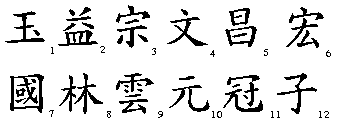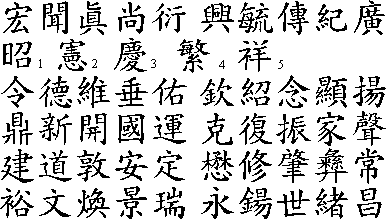Sung
| word |  | meaning | to dwell, to reside | |
|---|---|---|---|---|
| Pronunciation | Hakka | Cantonese | Mandarin | Japanese |
| sung4 | sung | sòng | sou | |
 or cug6pu5 (chuk4pu5/tuk4pu5) or clan register.
or cug6pu5 (chuk4pu5/tuk4pu5) or clan register.
Added to this notion of the clan register is the whole structure of the family, and extended family. It can be seen in the complex naming of relatives, which distinguish uncles and aunts by age and from the paternal, maternal and grandmaternal sides of the family. To help facilitate the correct relational aspect, Su Bui or generation names were used.
Generation names are used to distinguish someone's genealogical position in relation to all members of the same clan surname. By using them, terms of kinship and deference can be properly accorded. The term in Hakka for a generation name is Su Bui.
| word |  | meaning | to dwell, to reside | |
|---|---|---|---|---|
| Pronunciation | Hakka | Cantonese | Mandarin | Japanese |
| sung4 | sung | sòng | sou | |
is my family surname. (It is the same character used when refering to the Sung Dynasty, though it is not the name of that dynasty's surname (Lee3).) It took me a while to find its meaning, as it is no longer used for its original meaning. I found it first in a Japanese-English Kanji character dictionary, of all places. Its meaning had been preserved there and could be translated.
I am a second generation Hakka Chinese living in Britain. My father sailed here in the 1950's and found work as a cook. He is part of the old breed of 'lao3 fa2 kiao2' or 'chinese abroad'. Whichever way you look at it, they will always consider their chinese roots as home.
'Lok6 Dam1 Tsu3' is the term refering to my ancestor that first came the area in which my father was born. I am the eleventh generation direct decendent from him. He was originally from Lung2 Gong3 (LongGang/LongJiang???) in GuangDong Province, China. His generation name is Ngiuk6 meaning jade. From the table below, I estimate that he migrated down into the Shataukok Region about the Ming - Qing Dynasty boundary. Since we do not have any Zu Pu or Tuk6 Pu2 extant, all the information about him has been passed on orally.
 | ||||||
|---|---|---|---|---|---|---|
| # | H* | Meaning | Cantonese | Mandarin | Period** | |
| 1 | ngiuk6 | ngiug6 | jade | yuk | yu4 | c. 1650 |
| 2 | zid5 | yid5 | benefit | yat | yi1 | c.1680 |
| 3 | tsung1 | zung1 | ancestor, aim, purpose, authentic | jung | zong1 | c. 1710 |
| 4 | vun2 | vun2 | literature | man | wen2 | c. 1740 |
| 5 | tong1 | cong1 | prosperous | chong | chang1 | c. 1770 |
| 6 | hen2 | hen2, fen2 | grand, magnificent | wang | hong2 | c. 1800 |
| 7 | ged5 | ged5 | country | gwok | guo2 | c.1830 |
| 8 | lim2 | lim2 | grove | lam | lin2 | c.1860 |
| 9 | zun2 | yun2 | cloud | wan | yun2 | c. 1890 |
| 10 | ngen2 | ngian2 | origin | yuen | yuan2 | c.1920 |
| 11 | gon4 | gon4 | coronet | goon | guan1 | c. 1950 |
| 12 | tsu3 | zu3 | son | ji | zi3 | c. 1980 |
| *The pronunciations in Hakka are exactly the same, though they are spelled differently. | ** I have taken 30 years as the length of an average generation | |||||
I not quite sure of the character of the sixth generation, since I have not seen this list written down at all.
The approximate generation periods are not absolute. My own generation name is 'gon4' meaning coronet, or crown. However, someone I know who shares the same generation name as I do, is over 70 giving his birthdate in the 1920's. Also, there are some that I know who have the same generation name as my grandfather, though I am older.
Beyond the 12 generation name above, there are currently none fixed that I am aware of. If any member of the Sung4 clan who is Hakka, whose ancestors were from the region of LongGang in Guangdong province, and by tradition DO NOT eat dog meat, then I would be very glad to hear if you have knowledge of either the above sixth generation name, or any before or after those listed. You can contact me at the e-mail address here.
I have also the names of five generations of the Tsen1 family surname (C = Tsang, M = Zeng1). I am indebted to Mr. RI Chen (= Tsang) who has kindly supplied the Generation names of which the 5 I know from my mother is as labeled. He has also advised that the approximate dates be changed, for instance my original date for the Hen generation name was c.1920 should become 1910. But I have compromised here, by replacing it with c.1915 instead. The reason being that as a correlation, it fits better to my mother's side of the family, and flexible enough to account for Mr. Chen's own chronology. As a small point of interest, the fourth Generation name of this list corresponds roughly also to the Ming - Qing dynastic boundary, if as we have done, taken 30 years as the average generation gap.
 | meaning | to add to, more § |
|---|---|---|
| pronunciation | tsen | |
 | ||
| # | Hakka | Period |
| 1 | tsao1 | c.1885 |
| 2 | hen1 | c.1915 |
| 3 | kin4 | c.1945 |
| 4 | fan2 | c.1975 |
| 5 | siong2 | c.2005 |
| * 30 years per generation | ||
|
These are in Hakka PinYim:
fen2 vun2 zin1 song4 yan1, hin1 yug2 con2 gi4 gong3 zao1 hen3 kin4 fan2 siong2, gim1 ded5 viu2 sui2 yiu4, kim1 siu4 ngiam4 hian3 yong2 din3 sin1 hoi1 ged5 yun4, ked5 fug5 zen3 ga1 sang1 gian4 tao4 dun1 on1 tin4, mao4 xiu1 sao4 yi2 song2 yi4 vun2 fon4 gin3 sui4, yun2 xiag5 se4 yi4 cong1 |
||
| § meaning explained by Roger I. Chen in a special pageTsang Generational Names. | ||
My mother's generation is 'hen'. and was pleased to hear from Joseph Tsang.
Hi Mr Sung, Delighted to see your reference to the generation names of the Tsang family. We have kept the list with some twenty five names, (originally from a list of 60, which is the same for five families in China, including Kung( Confucius), Meng, Yan et Tse. My generation name is Fan and my son is Siong and my grandson is Lin. Then come Tet, Vui, Shui, Yu , etc etc. I live in Mauritus and my name is Tsang Fan Hin or Zeng Fan Xin in pinyin. 20 years is too long for a generation. It's around 20 years. Hope to hear from you. Joseph TsangRecently, I put forward my reasons for the 30 year length to him:
> > I think 20 years may be too short a period for the length of a generation. > Though it is possible to have one's eldest son at that age, it is a general > spread within the same generation which is interesting. Suppose the eldest > was born when his father was 20, it is perfectly reasonable that the father > would still have sons into his forties, though less often into his > fifties. So an average of the age in which the father is most likely to > have had a son would be when he is around 30. This is not the same as > having had a son at twenty. It is merely that at 30, he would have at least > sired one male offspring, on the basis of the most likely probability.